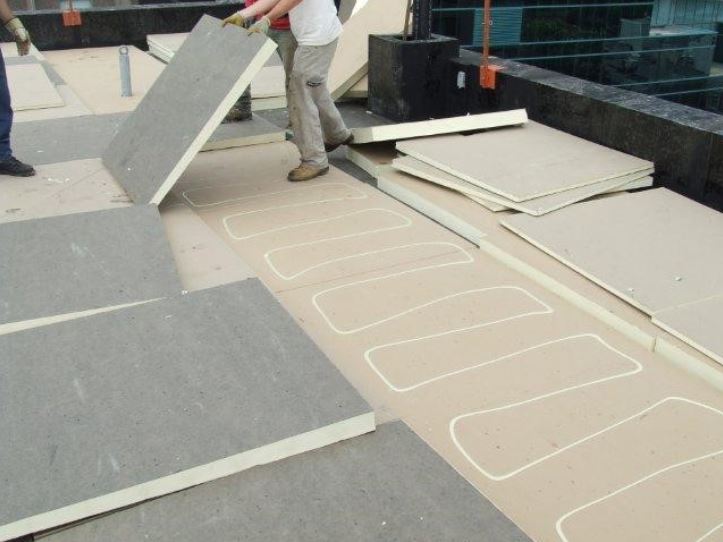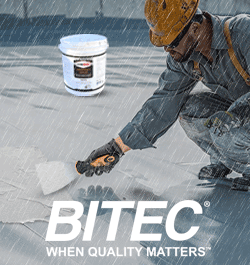What is Polyiso rigid foam insulation? A comprehensive guide

By IKO.
Use of Polyiso rigid foam insulation promotes energy efficiency and structural support.
What (exactly) is Polyiso?
Polyiso, or polyisocyanurate, is a rigid foam insulation used in more than 70% of commercial roof construction and offers a continuous insulation solution for commercial flat (low slope) roof insulation and wall assemblies. As one of North America’s most widely used and readily available building products, polyiso is a cost-effective insulation option for reducing building energy use and improving the overall service-life of roofs and walls.
Specifically, polyiso has four major components: MDI, polyol, a blowing agent and a flame retardant. When these components are mixed, along with small amounts of catalysts and surfactants, a heat-generating chemical reaction causes the liquid blowing agent to boil. The resultant blowing agent vapor expands the foam, creating gas-filled cells that provide polyiso’s high thermal-resistance value. The polyiso industry uses the hydrocarbon blowing agent pentane, which has zero ozone-depletion potential and negligible global-warming potential.
History/Why It’s Important
Polyisocyanurate was introduced in the building market during the late 1970s. At that time, chlorofluorocarbons (CFCs) were used in the manufacture of polyiso, with CFC-11 as the specific blowing agent. Although the history of the connection between CFCs and ozone layer depletion is well-documented, a brief timeline of the issue and its implications for the industry provides more details.
Throughout the 1970s and 1980s, the international community became increasingly concerned that Ozone Damaging Substances (ODS) would harm the ozone layer. The stratospheric ozone layer filters out harmful ultraviolet (UV) radiation. Exposure to UV rays are associated with an increased prevalence of skin cancer, cataracts, reduced agricultural productivity, and disruption of marine ecosystems. In 1985, the Vienna Convention for the Protection of the Ozone Layer formalized international cooperation on this issue. This cooperation resulted in the 1987 signing of the Montreal Protocol on Substances that Deplete the Ozone Layer.
Following the Montreal Protocol, new data showed worse-than-expected damage to the ozone layer. In 1992, the parties to the Protocol decided to alter the terms of the 1987 agreement to end production of CFCs by 1996 in developed countries. More information on the phaseout of ODS is available here. Because of measures taken under the Montreal Protocol, emissions of ODS are falling, and the ozone layer is expected to recover by the mid 21st century.
Specific to the roofing industry and polyiso as a product, the Polyisocyanurate Insulation Manufacturers Association (PIMA) was born out of a joint effort to find alternatives to the CFCs, with six founding members, including manufacturers and suppliers. For the first 15 years in the organization’s history, PIMA focused on finding and improving alternatives to CFCs and HCFCs. In 2002, the industry transitioned to non-ozone depleting substances that were also ozone friendly.
PIMA President Justin Koscher says the organization was formed at a time when CFC’s were being phased out and taxed. “Although CFC’s were used as the blowing agent used in manufacturing process of polyiso during the 1980s, they were later proven to destroy the ozone in the earth’s stratosphere,” he notes.
Benefits and Uses of Polyiso
Polyiso is a popular choice for commercial roofing insulation, as a roofing cover board, and in building envelope applications as an insulated wall sheathing. An alternative to other rigid foam plastic and fibrous insulation products, the many benefits of using polyiso products include:
- A high R-value per inch compared to other insulation products used in commercial construction
- Outstanding installed cost advantages and economical cost per R-value
- The ability to achieve today’s code required R-values while cost-effectively minimizing space, material, and labor requirements (see Sustainability below)
- Outstanding performance in fire tests, particularly in products such as IKOThermTM III.
- Ease of use and peace of mind, as polyiso products are designed for use in an expansive assortment of tested, approved, and code-compliant applications
- Polyiso is stable over a vast temperature range (-100°F to +250°F) (-37°C to +121°C) and can be used as a component in roof systems utilizing hot asphalt
- Polyiso offers a high compressive strength, excellent adhesion to facers, low water absorption and low vapor transmission
- Polyiso is compatible with most construction adhesives
Roof Insulation Products
Polyiso insulation is the most widely used low slope, above-deck commercial roofing insulation. While the focus of this article is on the commercial application of polyiso, keep in mind the product is also an excellent choice for home renovation.
As a versatile choice for commercial roofing applications, polyiso is designed to be part of any modified bitumen, built-up, or single-ply roofing system. Polyiso products feature a facer for high strength and excellent absorption for both hot mopping and adhesive attachment methods. The product also is designed to perform well with mechanical fasteners. Polyiso foam insulation features high thermal properties, which provide outstanding insulation protection and help to reduce heating and cooling costs.
Continuous product improvements are essential to the success of polyiso in commercial roofing applications. Polyiso offers the most extensive range of code approvals for insulation used in roof systems. It remains the only foam plastic insulation product to earn FM and UL Approval for direct to steel deck application without a thermal barrier. Polyiso also performs well in critical issues around fire performance, passing the FM 4450 calorimeter flame tests and the UL 1256 resistance to interior spread of flame test.
Roof Cover Board Products
Roof insulation cover boards also are widely used and specified because they are lightweight and easy to handle for contractors. Constructed from a rigid, closed cell polyisocyanurate foam core bonded on each side to coated glass fiber facers, the product’s inherently high thermal properties and compressive strength make it perfect for use as a cover board.
High-Density Polyiso (HDP) cover boards are becoming an essential component in roof systems, providing a stable substrate for roofing membranes as well as suitable protection for underlying insulation.
PIMA’s Koscher says adding a cover board will enhance overall roof system durability and can defray long-term maintenance costs. “Understanding the unique benefits of a high-density cover board product and key considerations when installing can help you reduce labor and save money during the construction process,” he notes. High-density cover boards also can contribute to lower building energy use costs during a roof system’s life.
In his article, “A Versatile Option,” in the June 2018 issue of Professional Roofing Magazine, he shares that high-density cover boards provide a combination of impact resistance, energy savings, and ease of installation. “By adding a cover board, roofing contractors can enhance the long-term performance of a commercial roof system,” Koscher comments.
Wall Sheathing Products
Insulated wall sheathing applications are growing throughout the industry because building codes now require continuous insulation. Continuous Insulation (CI) is defined as “insulation that is continuous across all structural members without thermal bridges other than fasteners and service openings. It is installed on the interior, exterior, or is integral to any opaque surface of the building envelope.”
Polyiso is equivalent to traditional gypsum in terms of fire resistance, moisture resistance, and wind uplift properties. However, polyiso has one of the highest R-values* per inch of thickness among common insulations such as expanded polystyrene (XPS) or extruded polystyrene (EPS), and more builders now are choosing polyiso insulation for use on and in walls. According to PIMA, foil-faced polyiso has a high R-value per inch; therefore, the design U-value of the cavity wall system can be achieved with a minimum thickness of insulation. This decreases the overall footprint of the building and can lower construction costs.
In cavity walls, polyiso’s foil face and R-value allow increased air space between inner and outer masonry wythes (a vertical section of bricks or other masonry that is one unit thick) to more efficiently divert water to the outside and improve long-term thermal performance. Products such as IKO’s Enerfoil and Ener-Air offer innovative insulation systems that are at the forefront of wall design for the building envelope.
The Sustainable Side of Polyiso
The value of insulation has been apparent to contractors and professionals in the building industry for many years. This fact even grabbed the attention of government leaders. In December 2009, President Barack Obama said that home insulation “is sexy,” in an appeal for Congress to pass incentives for homeowners who make their homes more energy efficient.
“Here’s what’s sexy about it. It saves money,” the president said at a Northern Virginia Home Depot store. Joined by members of Congress, labor and business leaders involved in building services to propose the lower use of natural resources consumed by homeowners, Obama called insulation “the in thing.”
A key component to polyiso’s sustainability is *R-Value. This is a measure of insulation’s ability to resist heat traveling through it. The higher the R-Value, the better the thermal performance of the insulation. If you want to determine minimum R-value requirements per ASHRAE 90.1, consider using EnergyWise Roof Calculator Online. The National Roofing Contractors Association (NRCA), in partnership with The Roofing Industry Alliance for Progress, developed this free, Web-based application based in part on the Prescriptive Building Envelope Option contained in ASHRAE Standard 90.1, versions 1999 (2001), 2004 and 2007.
The Roof Calculator also provides a graphical method of constructing roof assemblies to evaluate thermal performance and estimated energy costs under normal operating conditions. This application is intended to be a simplified guide.
Industry Support
The Polyisocyanurate Insulation Manufacturers Association (PIMA) serves as the unified voice of the rigid polyiso industry. Proactively advocating for safe, cost-effective, sustainable, and energy-efficient construction, PIMA celebrated its 30th anniversary in 2017. The association’s members include a synergistic partnership of polyiso manufacturers and industry suppliers.
PIMA works with representatives from all sectors of the building industry and a variety of trade organizations and environmental advocates to support policies promoting safe, cost-effective, sustainable, and energy-efficient construction. PIMA’s manufacturing and supplier partners (including IKO) represent significant downstream user groups, such as the National Roofing Contractors Association (NRCA) and the Building Owners and Manufacturers Association (BOMA). From the government side, the Environmental Protection Agency (EPA) and Department of Energy (DOE) support the industry with research and programs such as Energy Star to support products, as well as energy efficiency research through the DOE’s Building Technologies Office. “We align our advocacy efforts with other partner associations that support pro-energy efficiency policies like modern energy codes for residential and commercial construction or tax policies that incentivize investments that help lower energy use in the built environment,” says Koscher.
PIMA offers a wealth of information for anyone wanting to learn more about polyiso, including an extensive list of technical bulletins with in-depth information related to the use of polyiso in roofing, walls and cover board.
The Future of Polyiso
According to Koscher, there are important sustainability initiatives around zero net energy (ZNE) buildings that will continue to drive investments in energy efficiency technology. “In the NAFTA region, the U.S. and Canada lead the way. Whether it’s states like California and New York or national efforts in Canada, you will see more and more construction built to zero net energy (ZNE) or ZNE-ready standards,” he comments. “The use of energy efficient technologies like polyiso insulation have created a path for renewable energy to be more cost-effective in meeting the energy demands for buildings. An energy efficient building envelope is the foundation for any ZNE building,” he adds.
Another key point for the future of the built environment includes resiliency. Buildings are intentionally more constructed efficiently to handle disasters. “In an area where there are severe hurricanes, schools are built with added reinforcement and features to act as a shelter in the time of disaster,” says Koscher.
“Sustainable building insulation is the key to driving energy efficiency in the modern era,” said Koscher. “PIMA has been at the forefront of advancing this value proposition for decades, and we look forward to continuing to position polyiso’s significant role in reducing the built infrastructure’s impact on the environment and enhancing the performance of the buildings we live and work in each day.”
Polyiso is one of the nation’s most widely used and cost-effective foam insulation products available. To learn even more about outstanding polyiso commercial roofing and wall products, visit www.iko.com/comm/.
Source: IKO.



















Comments
Leave a Reply
Have an account? Login to leave a comment!
Sign In